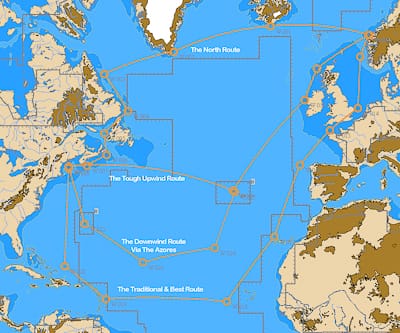Question: I have my 36′ Aage Nielsen yawl in Norway and I need to bring her home to Maine. I would appreciate your comments regarding my choice of routes.
One idea is down to the Azores and then over to the eastern US; the reverse of how I sailed to Europe. The other option I’m considering is going the northern route via The Shetlands, The Faeroes, Iceland, Greenland, Labrador and Newfoundland.
If going via the Azores, I would hope to do the crossing in June. If going over the top, I would plan for July.
My boat’s cockpit is very exposed and she doesn’t have any cabin heat to speak of. Being wooden, I don’t want to sail in ice. Plus, she’s 50+ years old and getting tired, so I’d like to avoid heavy [weather] conditions.

Answer: I would strongly caution you against the northern route via Iceland and Greenland. Those waters are no place for any boat that you don’t have 100% confidence in. In our experience, once you get west of Iceland gales will average at least one a week. Given your boat’s comparatively short water line and limited fuel capacity, the longer hops are going to take you well over a week and so the likelihood is that on such a passage you will have at least two full gales at sea and possibly a full-on storm, even in July. Add to that the cold, fog (plenty of that) and ice risk and it is just not something you should attempt in your boat. In summary, the northern route, even though the hops are short, is not an easy way home.

When you say via the Azores, I assume that you are thinking of swinging well south below the Bermuda-Azores high to pick up the tradewinds before curving north via Bermuda. If so, at that time of year, you are going to be very exposed for a long period to an early season tropical storm or even a hurricane with nowhere to run to. (If you tried to sail directly to Maine from the Azores you would be beating to windward into the westerlies and would also get a lot of fog and maybe ice on the Grand Banks—a very tough trip.)
The best way to cross the Atlantic east to west is still the traditional tradewind passage via the Canaries and the best timing is to get out of northern Europe in the late summer, before Biscay gets too bad, and then leave the Canaries in November, winter in the Caribbean and head north to Maine the following spring. But even that route is not without heavy weather risk: Biscay can deal out a caning at any time and it is even possible to hit a gale on the way across the southern North Atlantic. (In the last few weeks there have been a series of cutoff lows forming that will be producing gale force westerlies on parts of the trade wind route.)
I’m not sure what level of concern you have when you say that your boat is “getting tired” but if you are not reasonably confident of her ability to withstand a prolonged gale at sea, then the best way home for her is on the deck of a freighter. There is simply no way to cross the North Atlantic without a substantial risk of at least one gale, and any boat and crew undertaking such a passage should be able to withstand it.
By the way, I love the boat and would think that if she were sound and the cockpit watertight she would be very seaworthy, particularly since I expect that she heaves-to beautifully.

